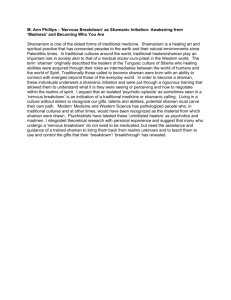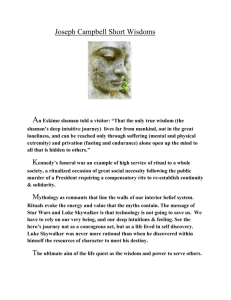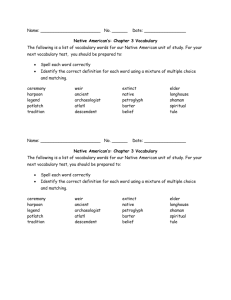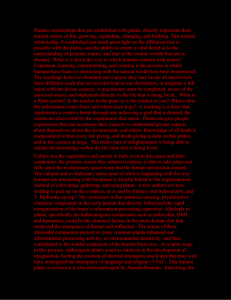Cowan Handout
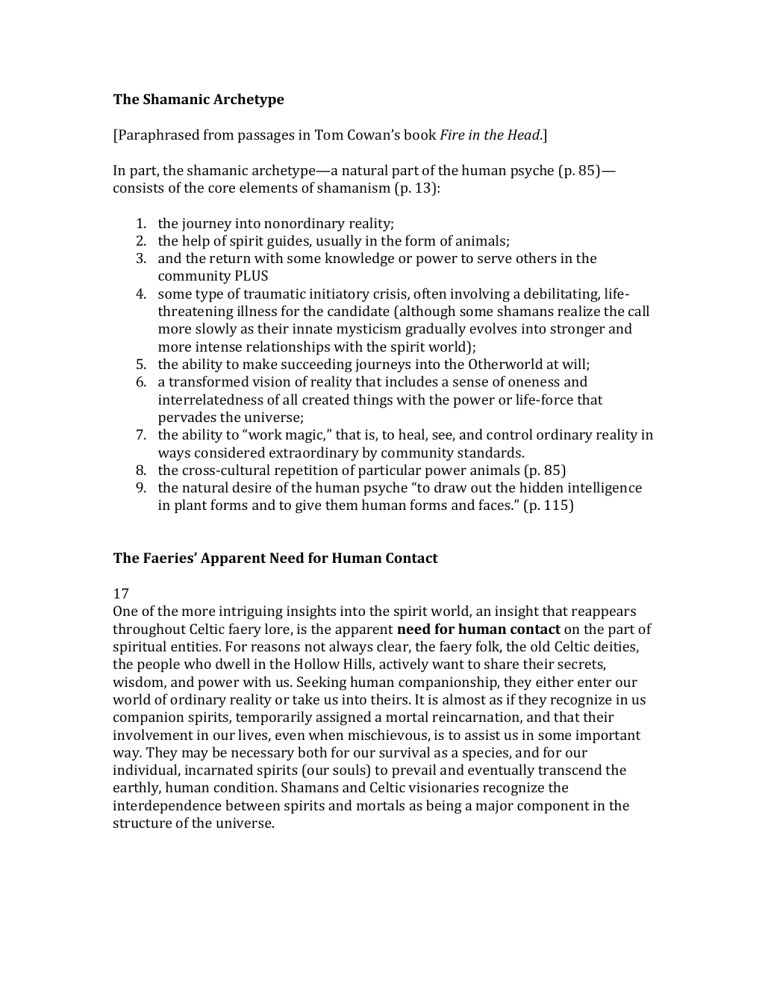
The Shamanic Archetype
[Paraphrased from passages in Tom Cowan’s book Fire in the Head.]
In part, the shamanic archetype—a natural part of the human psyche (p. 85)— consists of the core elements of shamanism (p. 13):
1.
the journey into nonordinary reality;
2.
the help of spirit guides, usually in the form of animals;
3.
and the return with some knowledge or power to serve others in the community PLUS
4.
some type of traumatic initiatory crisis, often involving a debilitating, lifethreatening illness for the candidate (although some shamans realize the call more slowly as their innate mysticism gradually evolves into stronger and more intense relationships with the spirit world);
5.
the ability to make succeeding journeys into the Otherworld at will;
6.
a transformed vision of reality that includes a sense of oneness and interrelatedness of all created things with the power or life-force that pervades the universe;
7.
the ability to “work magic,” that is, to heal, see, and control ordinary reality in ways considered extraordinary by community standards.
8.
the cross-cultural repetition of particular power animals (p. 85)
9.
the natural desire of the human psyche “to draw out the hidden intelligence in plant forms and to give them human forms and faces.” (p. 115)
The Faeries’ Apparent Need for Human Contact
17
One of the more intriguing insights into the spirit world, an insight that reappears throughout Celtic faery lore, is the apparent need for human contact on the part of spiritual entities. For reasons not always clear, the faery folk, the old Celtic deities, the people who dwell in the Hollow Hills, actively want to share their secrets, wisdom, and power with us. Seeking human companionship, they either enter our world of ordinary reality or take us into theirs. It is almost as if they recognize in us companion spirits, temporarily assigned a mortal reincarnation, and that their involvement in our lives, even when mischievous, is to assist us in some important way. They may be necessary both for our survival as a species, and for our individual, incarnated spirits (our souls) to prevail and eventually transcend the earthly, human condition. Shamans and Celtic visionaries recognize the interdependence between spirits and mortals as being a major component in the structure of the universe.
Cowan Handout 1 / 2
Imaginal & Imagination
Otherworld & Collective Imagination = Imaginal realm independent of individual imagination
3-4
Because the nonordinary realms are for the most part immaterial and to a large extent imaginal, shamans speak of them as spirit realms and the entities there are considered spirits.
I have qualified the terms immaterial and imaginal intentionally because the realm of spirit, or nonordinary reality, is greater than our human perception of it and often defies most descriptions of how we expect to operate. For example, the spirit world seems to be immaterial, or nonphysical, but activities performed in that world have astounding repercussions in ordinary reality. In healing, for instance, a shaman may journey into nonordinary reality to retrieve the soul of a dying person or to remove the causes of illness that may appear as insects or demons. In such cases, the shaman treats the invisible, spiritual nature of the sickness, yet the physical body recovers. The same is true of the term imaginal. For example, a shaman may journey to a place in nonordinary reality and speak of it as a realm of the spirit world, then later learn that such a place exists in ordinary, physical reality. It may turn out that other shamans have also traveled there (either in the body or out of the body) and are also familiar with it, thus indicating that the Otherworld has an existence
independent of the individual shaman’s imagination. In addition, the widespread testimony to the manifestation of spirit entities in the physical realm suggests that they too can appear and operate in the ordinary, physical world, at least partially independent of the imagination of the person seeing them.
8 In some respects, Aengus’s journey is a classic shamanic soul journey, illuminated by the
imagination. But calling attention to that does not lessen its authenticity, for the imagination is the
shaman’s visionary tool that describes the contents of the imaginal realm of consciousness, and the survival of shamanism over the last 20,000 years strongly suggests that the tool works.
13 The full shamanic experience occurs in a trancelike, nonordinary state of consciousness. The physical and psychological ramifications of this state of consciousness are currently being studied, and it appears to be a unique mode of awareness similar to, but significantly different from, other visionary states such as dreaming, hypnotism, uncontrollable hallucinations, revery, out-of-body experiences, and near-death experiences.
[Creative Imagination]
25
Certainly the oldest tales and legends about the origins of a people and their culture heroes had to have been first articulated by someone who today would be said to have a “creative imagination.” I use this term to refer to a person’s ability to describe and impart shape and structure to
visionary experiences, not to imply that the products of the imagination are fantasy, mere speculation, or raving hallucinations that have no basis in ordinary or nonordinary reality. Even if the products of the imagination are in some mundane sense “not real,” certainly the human being in whose imagination they occur is real, is historical. It is similar to arguing that both a dream and the content of a dream are real, but each in a different way. Of course, the dreamer, too, is real, also in a way that differs from the dream and the dream’s content.
198 What strikes us here in terms of shamanic sensibilities is not just the idea that “heaven is on earth,” but that what is seen in dreams or in imaginative revery, is vital information in visionary form, and that the vision is, in fact, a fact—a spiritual fact, not apparent to those who have lost this older, Celtic faith.
Cowan Handout 1 / 3
Cowan on Shifting
29 [the ability to “be in” everything in creation] is a key component of shamanism. The shaman’s
“techniques of ecstasy” are not just techniques for standing outside one’s own consciousness, although getting outside one’s self is the first movement of the soul on the shamanic journey. The next step is truly what distinguishes the shaman from other out-of-body sojourners: the ability to enter other realms of existence, participate in the secret lives of other creatures, and communicate with their inner spirits. The ability to send one’s own consciousness into the consciousness of another entity—whether it be the wind, a hawk, a string on a harp, or an entire landscape, either in this world or the Otherworld—and return to one’s own self is at the heart of the shaman’s journey.
30 the interconnectedness of all created things, commonly referred to as the Circle or Web of Life
30 The Shifting of Consciousness
The shaman is a master of escaping the mind-body matrix that characterizes ordinary consciousness and entering the shamanic or nonordinary state of consciousness. In this dream-like state the imaginal realm reshapes itself, creating a placeless, timeless field in which the shaman can participate in the consciousness of other creatures. It is at this point that shamanic journeying and shapeshifting share a common enterprise. Shapeshifting requires reshaping the imaginal realm, and consciousness becomes objectified in some other thing. Journeying reshapes the imaginal realm, and consciousness becomes geographied; it becomes the spirit world in which the shaman will travel.
Shapeshifting is consciousness-as-object; journeying is consciousness-as-landscape.
31 Journeying and shapeshifting are both forms of entering or merging. In journeying the shaman enters the spirit world. In shapeshifting the shaman enters the spirit of an animal, plant, or object. In both cases, the shaman’s imaginal realm reshapes itself (spontaneously and by will of the shaman) so the shaman’s consciousness can flow into and merge with the consciousness of something else. To agreater or lesser extent, depending on the power or desire of the shaman, some percentage of his or her consciousness becomes the consciousness of the other thing, and some percentage, usually smaller, remains the shaman’s so he or she retains control over the experience and can return to the ordinary state.
Shapeshifting, like the shamanic journey, begins in the mind, in the imagination, which is the shaman’s tool for describing the content of the imaginal realm, or nonordinary reality. Once the shaman’s consciousness has shifted, its inner structure has reshaped itself, and the shaman participates in the consciousness of another animal, plant, or object. The shaman’s aura may actually take on the plant’s shape or radiate the energy associated with the animal. Finally, when these changes have occurred, and if the shaman is powerful enough, the physical body is transformed so others can see the change. The shaman will then look and act like the animal, plant, or object.
Although the physical transformation may be the most dramatic aspect of shapeshifting for onlookers, it is not the most important. Were a shaman to shift his or her physical body without the important shift in consciousness, the feat would bestow little power or knowledge upon the shapeshifter. It would be form without substance. It would be mere showmanship, lacking the deep identification of subject with object, an identification attested to by many shamans who become their spirits or, in some rare cases, are temporarily possessed by them.
191 In ecstatic trance the shaman goes somewhere else, and becomes something else. He or she visits the worlds that lie beyond the horizon of the imagination and becomes animals, plants and other physical objects. The paradox is that in order to explore and shapeshift into any (or every) aspect of creation, shamans must partially “uncreate” themselves, or dissociate the soul from the body, or become spirit. In short, they must “die.”
Cowan Handout 1 / 4
Anthropomorphic Imagination
106 Understandably, we think of these spirits in human terms because the imagination works best with familiarity. Anthropomorphic visions of the spirit behind and within nature make it easier for the human mind to process unknowable mysteries.
108 in the Celtic imagination
109 Second, the dark thicket of trees provided the sensory deprivation needed to block out the human world of ordinary reality in order to concentrate on the inner world, giving the druid novices opportunity to hone the imaginal skills used in visionary experience.
110 oral culture, imagination
[Personalizing: From the Particular to the Universal]
110-11 There is great wisdom in personalizing the physical world. Relationship requires a sense of respect and equality for the other, and to cultivate a relationship with the Divine demands that we treat with respect and equality the natural world that contains the Divine. This is one of the shaman’s great insights: we can approach the Divine Mystery of the Universe through nature, and our relationship with the Divine evolves from our partnership with nature. Shamans also demonstrate that we cannot launch an undifferentiated relationship with “nature as a whole.” We must begin on
a smaller, more personal level—with one special animal spirit, or power animal—and progress from there to other animals, plants, rivers, hills, trees, and sacred places. Eventually our familiarity with the individual aspects of nature leads us to nature’s gods and goddesses, and finally to the
Divine Creator behind creation.
114 In the Celtic imagination, the forest was not just beautiful; it was divine.
115-16 As William Anderson puts it in his study of the Green Man, it is a natural human desire “to draw out the hidden intelligence in plant forms and to give them human forms and faces.” Perhaps the desire is part of the human psyche and an aspect of the shamanic archetype that nurtures in each person the hope that the intelligence behind the universe—perceived as spirits, faeries, or
Green Men— is not totally hidden from view, and that there are people trained in ecstatic techniques who know how to journey to invisible places to contact that woodland intelligence and tap into its fertile power and energy.
[Participatory Consciousness]
118-19 We have lost the ability to even imagine a culture that lives by the belief that human consciousness can participate in the natural world and that the natural world responds to the will of human consciousness. This is the consciousness of the shaman, and I might add, the ordinary
consciousness of the shaman, for even in a nontrance state of mind, the shaman saw and understood a different reality than we do today.
It is this participatory consciousness that is represented in images of figures that are part animal, part human, the most spectacular and awe-inspiring being that of the Horned Man.
